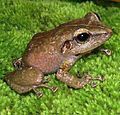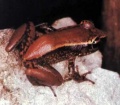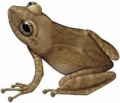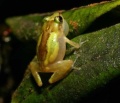AY Honors/Coquí - Advanced/Answer Key
1. Have the Coquí honor.
For tips and instruction see Coquí.
2. Demonstrate slides or photos of five different coquís than those demonstrated in the basic honor, giving the scientific name.
3. Demonstrate slides or photos of two Eleutherodactylus in other countries, besides Puerto Rico.
4. Which are the only coquís that sing or call during the day and why do they do it?
Common coquí (Eleutherodactylus coqui)
Hedrick's coquí (Eleutherodactylus hedricki)
Mountain coquí (also known as upland coquí, Puerto Rican robber frog), (Eleutherodactylus portoricensis)
Melodious coquí (Eleutherodactylus wightmanae)
They sing in the day to protect their territory.
5. Which coquís live in the following habitats:
a. Floor of the forest.
Melodious coquí (Eleutherodactylus wightmanae)
Mona coquí (Eleutherodactylus monensis)
Richmond's coquí, a.k.a. Bronze coquí (Eleutherodactylus richmondi)
b. Under the ground, fallen leaves and roots in the cloud forest of El Yunque National Forest.
Dwarf coquí (Eleutherodactylus unicolor)
c. High vegetation.
Mountain coquí, a.k.a. upland coquí, Puerto Rican robber frog (Eleutherodactylus portoricensis)
Eneida's coquí (Eleutherodactylus eneidae)
Common coquí (Eleutherodactylus coqui)
d. In the grass.
Grass coquí (Eleutherodactylus brittoni)
e. Low vegetation.
Red-eyed coquí (Eleutherodactylus antillensis)
Locust coquí (Eleutherodactylus locustus)
f. Bromeliads.
golden coquí (Eleutherodactylus jasperi)
Cricket coquí (Eleutherodactylus gryllus)
g. Caves known as the "guajonales."
Puerto Rican rock frog, locally known as the coquí guajón (Eleutherodactylus cooki)
h. In rivers and streams.
web-footed coquí (Eleutherodactylus karlschmidti)
i. In trees.
Hedrick's coquí (Eleutherodactylus hedricki)
j. In the herbaceous wetlands of Sabana Seca (Toa Baja).
Plain's coquí (Eleutherodactylus juanariveroi)
6. Of the Puerto Rican coquí, which:
a. is the only one with webbed feet?
The web-footed coquí.
b. does not lay eggs?
The golden coquí.
c. doesn't have a t-shape in its terminal phalanx?
The Dwarf coquí.
d. demonstrates sexual dimorphism?
e. is the only one endemic to El Yunque, Puerto Rico?
The Dwarf coquí.
f. is known as the "demon of Puerto Rico?"
g. has lower reproductive capacity?
The Plain's coquí.
7. Among frogs, toads and coquís, the female usually is larger than the male. Among the coquís of Puerto Rico, which male is larger than the female?
The web-footed coquí.
8. Among the coquís, who is responsible for the care and incubation of the brood of eggs?
The male is responsible.
9. What is the lifespan of the coquí?
2 years in the wild, 4 years in captivity.
















